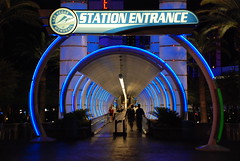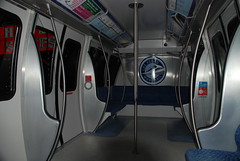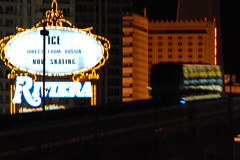
I saw the enticing neon space-age tunnel into the Bally’s casino/monorail station and couldn’t resist. Walking through those blue rings of light was the best part of the experience. So how was it? First off, this was not really the entrance to the monorail. I followed occasional signs for close to half a mile past restaurants, bars, and poker tables, through seas of slot machines and a shopping mall, past a pool and gym, before finding the promised station. Although I nearly lost my way a number of times because of the lack of signage—what happened to the neon-wrapped tunnel?—I’m pretty sure I took the most direct route. Although every building entrance on the strip in lavishly obvious, with recorded voices guiding the way even if you are no longer seeing straight, in addition to the fountains, volcanoes and pirate shows, everything in Las Vegas seems planned to prevent you from finding the exit once you’re inside.

The monorail itself. Five bucks for a single ride—a bit pricey, but apparently the trams run every 7 minutes all night long! See Muni, see BART, it’s not too much to ask. I could have just as easily walked, but it would have meant enduring the exact same casino instead of another virtually-the-same casino, and I’d already spent $6 on an MGD. Besides, how often do you get to ride on a monorail, right? Once you’ve gone through the gates and up the escalator, you don’t get a very good look at the trains because the platforms are the now-popular style with a wall of doors that line up with and are synchronized to open at the same time as the car doors so nobody can fall on the tracks. Maybe not a bad idea on a transit system designed to get people back to their hotels after a night of gambling and drinking rather than to and from a sober work place.

Between the closely-spaced casinos, it runs quite slowly, but this isn’t a deal-breaker compared to the pedestrian and car traffic on the strip. To experience a little more, I rode past my stop, out to the hotels, and back on a longer faster stretch--fast being a relative term. Just like the Disney monorail, the sleek design leads you to imagine zipping along fast enough to get a ticket in the Nevada desert. In reality they go no faster than a car on a city street. I suppose the advantage of being on an elevated rail is not having to stop for intersections or wait for traffic. What most interfered with the feeling of speed was slowing to a crawl to go around the unbanked 90-degree turns. And the ride was surprisingly bumpy—a serious aesthetic mismatch. Isn’t smoothness a major part of the super-modern future?
Despite the way-out-back station locations and other drawbacks, the monorail still seems to be useful for the particular needs this unusual city. It’s unfortunate that they didn’t do it well enough to make other cities consider a monorail as a real way of getting people around and not just a novelty.
No comments:
Post a Comment